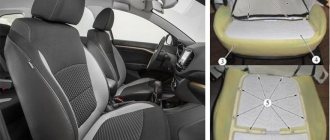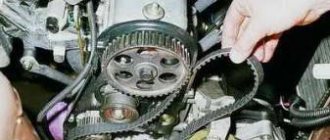All drivers know, either from their own experience or from the words of other motorists, that there is a possibility of problems with battery operation.
This problem happens especially often in winter at low temperatures. Usually, an inexperienced driver finds out about problems with the battery completely unexpectedly. Everyone can imagine that in the morning you need to go to work, but the car just “sneezes” and won’t start.
To avoid getting into a similar situation, the battery, like other units, requires constant and careful care.
Car battery: about the device
A battery (rechargeable acid battery) is a type of electrical storage battery that is used in vehicles. In electric vehicles, batteries are the main source of energy and are therefore called “traction”. And on conventional vehicles it is an auxiliary source of energy.
A car battery is designed to perform several key and a number of additional functions. First of all, the battery is a power source for starting the engine starter and for automotive lighting equipment (headlights, turn signals, brake lights). The battery provides uninterrupted power to all electrical devices in the car: interior and trunk lighting lamps, power windows, radio, alarm system, etc. The battery also supports the generator at increased loads.
Modern vehicles use lead-acid . This is a container that consists of six separate sections (in common parlance – cans), sequentially combined into one battery. Each section is a separate power source, generating about 2.1...2.2V. Inside each can there are lead plates filled with electrolyte, positive and negative, separated from each other.
The electrolyte is a mixture of distilled water and sulfuric acid, having a density in the range of 1.23-1.31 g/cm³. The higher the density of the electrolyte, the more frost-resistant the battery is. New car batteries made using progressive AGM technology have also been developed. In them, the electrolyte is absorbed into fiberglass. There are also gel batteries in which the electrolyte is thickened to a gel-like consistency with silica gel.
What types of batteries are there?
Serviced
Batteries of this type have so-called filler plugs. These plugs are used to control the density of the electrolyte, as well as to check the current level. If you care for a car battery of this type skillfully and regularly, it can serve without fail for quite a long time. However, every year the production of batteries from this group is constantly declining.
Out of service
These batteries do not require continuous monitoring of the electrolyte level and its maintenance as it is consumed. Features of this group of batteries include the presence of a special valve for removing gases and the possibility of periodic recharging. The majority of batteries available on the market today belong to this group.
In winter, many car owners begin to seriously “torment” batteries in order to start the engine of their car. However, the battery is not always the reason why a car won't start. This depends on a number of other factors, such as the quality of engine oil, gasoline, the condition of the glow plug, etc. Therefore, first it is better to find out the reason for the stubbornness of the “car”, and not to continue to drive the battery.
The surface of the battery must always be clean and this must be carefully monitored. Pay attention to the terminals - they should not be covered with a layer of dirt or an oxide film.
If a battery is used for a long time, its terminals very often become oxidized. The resulting plaque has a high ohmic resistance and is a poor conductor of electric current. For this reason, it should be cleaned using sandpaper and ammonia.
Also, in batteries of a non-maintenance type, the gas outlet hole is often clogged. If this is discovered during visual inspection, then the hole needs to be cleaned. Otherwise, the accumulated gases will damage the battery case.
Voltage. Standards. Maintained and unmaintained batteries
Until the end of the 40s, all production cars in the world were equipped with six-volt batteries. Nowadays these can only be found on light motorcycles. All modern cars and motorcycles with gasoline engines and light diesel vehicles use 12V batteries, and heavy diesel vehicles use 24-volt batteries (or two 12-volt batteries connected in series).
Nowadays, you won’t find standard car batteries in retail sales like they were in the Soviet Union. At that time, all car batteries were manufactured according to the same standard and could be fully serviced; take it apart, literally, piece by piece. The jars filled with electrolyte were placed in a strong black ebonite body and filled with mastic. Now there is simply an unrealistically large number of battery manufacturers on the market, and car batteries are not made according to any specific standard. Although there is a corresponding GOST: GOST 53165-2008 has been in force since July 1, 2009.
It is necessary to maintain modern batteries by being aware of some of their features, which are not complicated. For example: if the battery does not have the ability to top up with distilled water, then you should periodically use chargers that will maintain the desired voltage level. Such preventative maintenance is done to ensure that the battery lasts as long as possible and does not “die out” ahead of time.
Modern cars are equipped with reliable batteries with a long service life and, accordingly, with significant service life. A new battery lasts about five years (of course, provided that the car is used regularly, without long periods of downtime). If you provide your car's battery with proper care, it will last even longer. While a complete lack of battery maintenance may well cause its malfunction and irreversible processes that will make its further use impossible: no matter how much you charge, there will be no use.
Based on the principle of the need for maintenance, car batteries are divided into serviceable (sometimes referred to as “low-maintenance” as a subcategory) and maintenance-free (in the GOST text called “maintenance-free”). Maintenance-free car batteries, unlike serviced ones, do not have special technological holes with plugs for monitoring the level and topping up the electrolyte. In the event of a critical drop in the liquid level or a critical decrease in density, such a battery simply must be replaced with a serviceable one. This is what numerous (in any major city) offices offer, which with one call will come to you with a new battery, “delivered to your home.” And they will sell it to you, taking into account a discount for the old one, which they will take for restoration.
Types of batteries
Batteries are installed on absolutely all vehicles, and car manufacturers have not yet come up with an alternative to them. Today you can find quite a wide variety of batteries, both by operating principle and by manufacturer. We will try to deal with the so-called conventional acid batteries, since AGM and helium options are somewhat different.
Acid batteries can be divided into two types:
- Serviceable batteries. These devices include batteries that have filler plugs that allow you to independently control the level and density of the electrolyte. If necessary, electrolyte can be added to bring its level to the optimal level. Such batteries are durable and reliable in operation, but require very careful maintenance. In the automotive market today they are not particularly widespread and their number is constantly decreasing.
- Maintenance free batteries. This battery option occupies the majority of the car battery market. These devices differ in that it is impossible to control and add electrolyte to them. Manufacturers strive to limit as much as possible the direct intervention of owners in the operation of the system. Structurally, the difference is the fact that they do not have plugs for refilling the electrolyte, but they have a special hole for removing excess gases, eliminating the possibility of damage to the case.
Caring for serviced batteries
Maintained batteries require regular monitoring of the electrolyte condition and regular recharging using a stationary charger. Periodically it is necessary to monitor the electrolyte level in each of the six compartments and determine its density using a hydrometer. For this purpose, this device provides a number of floats with different specific gravity, and a bulb for filling the body.
So, batteries of the serviced type have special technological holes for filling electrolyte, tightly closed with plugs. Maintenance-free car batteries do not have such technological holes.
The electrolyte level is checked visually or using a special measuring tube. If the level drops, distilled water is added to the section jars, which is sold at any auto parts store or pharmacy. The density of the electrolyte is measured with a hydrometer and the charge level is estimated from it. A decrease in electrolyte density by 0.01 g/cm3 indicates a decrease in charge by 6 percent. The serviceability of the battery is checked with a special device - a load fork. The battery is considered working if the voltage does not drop for at least five seconds.
In especially hot seasons, you can reduce the rapid evaporation of water in the battery by dropping a couple of drops of autol into each section. The only warning: in this case, it is necessary to clearly control the electrolyte level so that it does not drop to the level where the tops of the lead plates are exposed.
Battery storage
- If you are going to put the car in the garage for the entire cold period of the year, then the battery should be removed and stored in a warm place. Long-term exposure of a battery to negative temperatures can reduce its capacity and shorten its service life.
- When you put the battery away for storage, you need to pay great attention to securely fixing the terminals. If the contact is poor, problems may arise with starting the car, because the required charge from the battery will not flow.
- Check monthly how the wires are secured to the terminals and, if necessary, tighten the clamps so that the connection is stationary.
- Maintained batteries require regular checking of the electrolyte condition. If the level becomes a little lower, you need to add distillate. But in cases where the electrolyte level has dropped by half or below, most likely the battery has mechanical damage, which has resulted in a loss of seal and is dangerous for further use.
Caring for maintenance-free batteries
Modern maintenance-free “calcium” batteries have low self-discharge and do not require special care. At the same time, they do not tolerate deep discharges (for example, during short trips in winter frosts, or when parking a car for a long time).
But for well-maintained and low-maintenance batteries, which are now practically not produced, deep discharge is not so destructive. But these types of batteries require topping up with new portions of distilled water (if the electrical equipment is in good working order and the mileage is average, this should be done approximately once every 4-7 months).
Maintenance-free car batteries do not mean that such a battery does not require any maintenance at all. Most often, modern maintenance-free car batteries have a built-in hydrometer (a device for measuring the electrolyte level), in the form of an indicator, by the color of which you can determine the density of the electrolyte. A green belt indicates normal density, red or white indicates low density (the battery must be replaced). Also, in maintenance-free batteries, it is necessary to periodically monitor the electrolyte level using the marks on their cases.
Types and differences in care
The battery life directly depends on how well it is cared for. This device supplies other systems with electrical energy, thanks to which the car can move.
There are two types of batteries: maintenance-free and maintenance-free.
The first type is the most common; it really does not require maintenance for 5–7 years. According to the manufacturer, there is no need to check the density, add electrolyte or check the charge.
Maintenance-free batteries are easier to use. I set them and forgot about them for 7 years. After which I replaced it with a new one. It's more expensive, but you don't have to bother with cleaning and washing.
Serviced devices require regular maintenance. With proper maintenance, they can be used for a long time. Such batteries are gradually leaving the automotive market, but many still continue to use them.
General (for all types of batteries) rules for caring for them
On all car batteries without exception, it is necessary to regularly monitor the tightness of their housing and filler plugs; Keep special drainage holes clean. If signs of electrolyte leakage appear, the leak must be eliminated. And don’t forget to thoroughly rinse the body and battery compartment of the car with a neutralizing alkaline compound (soda, in other words). The battery must not be undercharged when traveling (to do this you need to monitor the operation of the generator). Immediately contact an auto electrician if any abnormalities are detected in the operation of any electrical equipment from the “arsenal” that is “on board” the car.
It is also necessary to periodically clean and lightly lubricate the terminals (lithium grease). This achieves the removal of gradually growing oxides between the battery terminals and wire clamps and the protection of the terminals from electrocorrosive destruction. It is also necessary to check whether the terminals are loose.
Once every six months you need to recharge your car battery using a stationary charger from the mains (this is especially important for older batteries). If the winter is frosty, then monthly recharging of the battery with a network device will not hurt. You constantly need to monitor the appearance of the battery, wipe its body with a rag soaked in a soda solution, and remove any dirt that may arise.
Periodically you need to practice checking the voltage at the battery terminals with the engine idling. This procedure allows you to determine the level of charge provided by the generator. If the voltage is in the range from 12.5V to 14.5V, this means that the unit is working properly and is operating normally. Deviations from the specified parameters indicate wear of the generator and the need to diagnose it to eliminate the malfunction. And after the repair, you also need to repeat the control measures, in different operating modes. Including when the headlights and other consumers of electrical energy are on.
In cases where the voltage at the terminals drops below 10.5 V, then this is a value that will not be enough to start the engine. This battery needs to be charged.
If the car will not be used for a long time, then the mass must be disconnected. This simple action will prevent natural self-discharge of the battery.
It is also important to check the reliability of the battery fastening and timely, if necessary, tightening the nuts or bolts. Loose fasteners and a battery that “dances” during a trip create conditions for damage to the case and (or) leakage of electrolyte.
Car battery life
A battery is a kind of small factory that produces and transmits electricity to a machine. It is this energy that starts the operation of the vehicle engine. Like any complex unit, a battery has its own service life. Good batteries can serve their owner for 5 and sometimes 10 years. This will depend on many factors, one of the main ones, we can confidently consider, is good battery care. What do experts refer to such care? Let's figure it out together.
Factors that adversely affect the battery
The need to carry out the routine maintenance work described above to care for the battery is determined by the following factors. They inevitably arise during the operation of the car. So, it is always possible:
- deviations in charge parameters due to generator malfunctions;
- loss of charge due to prolonged inactivity of the vehicle with the battery not disconnected;
- Low air temperatures outside lead to a drop in the density of the electrolyte and the charge level, to a level at which it is impossible to start the engine with the starter.
Storage and fixation
The battery terminals should always be securely secured. If they are not clamped well, then when overcoming some bump, the battery may become disconnected and the car will simply stall.
This is an extremely dangerous situation that leads to a number of other troubles. For example, deterioration in brake performance or steering wheel locking. If this happens while driving, an uncontrolled or poorly controlled vehicle can cause a serious accident. Therefore, before the trip, it is highly advisable to verify the quality of the terminals.
If the vehicle will not be used for quite a long time, then it is necessary to provide the battery with optimal storage conditions in advance. The device must be turned off and removed from the car, since sub-zero temperatures can render it unusable. It is advisable to store the battery in a sufficiently warm and dry room. But you don’t need to place it next to heat sources, otherwise the device will quickly discharge.
Deep discharge of the device can negatively affect its condition. To prevent problems, it is advisable to recharge the battery every 3-4 months. So, the device will last as long as possible.
To ensure the safest and most reliable use of the device, it must be properly secured. To check the fixation, you can try to move the battery by hand, turning off the engine first.
It must be taken into account that if the terminals are incorrectly secured, the charging process may be disrupted. Thus, a crooked plane and poorly installed terminals often become the reasons why the car constantly stalls. This affects not only the convenience, but also the safety of vehicle operation.
Maintenance of a dry-charged battery. Battery restoration
If you purchase a dry-charged battery, it will need to be filled with electrolyte with a density of 1.27 g/cm3 to the specified level. No earlier than twenty minutes and no later than two hours, a hydrometer test is carried out.
If the density drop does not exceed 0.03 g/cm3, then the battery can be installed on a car for operation. Otherwise, you still need to connect the charger. The electric charge current should not exceed 10 percent of the nominal value. The procedure is carried out until an abundant release of gases appears in the jars. After this, the density and level are re-monitored, and if necessary, distilled water is added to the jars.
After which the charger is connected again (for half an hour) to evenly distribute the electrolyte throughout the entire volume of the can sections. After this, the car battery is definitely ready for use and can be installed on the car for long-term use.
The car battery is restored by charging it with a low current for a long time. If, after a long time, the density of the electrolyte begins to increase, then this is a sign of a positive recovery result. As the charge continues, it is quite possible that it will increase to the level required for normal operation.
In cases where the battery plates are in working condition, it is possible to increase the density of the electrolyte by adding sulfuric acid with a specific indicator of 1.4 g/cm3. It is easy to revive a completely discharged battery in a specialized workshop. To do this, use a special charging technique in distilled water.











